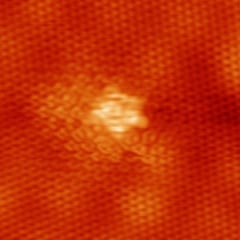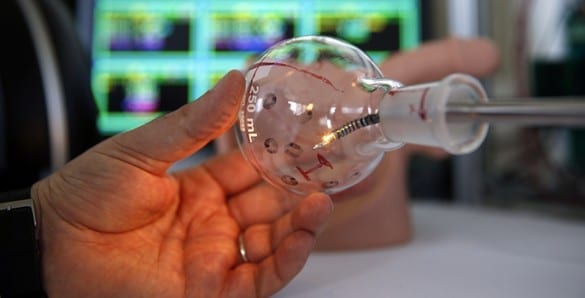
There is a substance that is about to change our lives: in some ways perceptibly, and in others hidden from view, but nonetheless profound in application and implication for future technology based products.
The substance is Graphene. A single layer of carbon atoms, laid out in a honeycomb structure that is the thinnest, and yet one of the strongest, substance in use at the nanotechnology level.
Its properties include incredible density, transparency, efficient heat and electrical conduction, and high flexibility. Its applications include electrodynamics, physical and organic chemistry, thermodynamics, semiconductor design, and flat screen technologies.
With a huge array of potential applications, it is no wonder that firms, state enterprises and research institutes are clamoring to take out patents to begin the “walling off process” of potential product and market spaces – thereby creating barriers to entry, behind which future revenue streams will accrue.
This is a crucial point for all governments, but especially UK PLC. Firms in China, the US and South Korea lead the way in the number of patents filed over the past five years in potential applications of Graphene. According to Cambridge IP, the world’s top ten Graphene patent owners are (listed alphabetically):
- · International Business Machines (IBM)
- · Korea Advanced Institute of Science and Technology (KAIST)
- · Rice University (William Marsh)
- · Samsung (South Korea)
- · Sandisk 3D LLC
- · Sungyunkwan University
- · Tsinghua University
- · Xerox Corp
- · Zhejiang University
When we list the patents filed by Research Institute, the table, in terms of percentage shares of the approximately 7,500 patents filed to date, looks as follows:
Chinese firms and Institutes lead the way with 2,204 patent publications, or 30 percent of the filed patents, followed by U.S. entities with 1,754, or 23 percent of filed patents, then South Korea with 1,160, or 15 percent of filed patents, and finally the UK owning 54 filed patents, which is less than one percent.
This means that 68 percent of all patents filed on Graphene derivatives and uses have been taken out by firms and institutes in just three countries, China, the U.S., and South Korea.
The scatter gun approach, especially taken by the Chinese, is similar in result, if not process, of Japanese firms acquiring Cambridge-based Silicon Fen startup companies, in high technology industries, to get access to their portfolios of patents and future products and markets.
This will give Chinese, U.S., and South Korean firms first mover advantages as product/market spaces open, to fully exploit those opportunities under the protective cloak of the patent system. But it will also allow them to legally defend those products and markets, foreclosing options for competitors, and have a higher degree of early life cycle monopolization over value chains of products and services created in the nascent Graphene ecosystems. And when those nascent ecosystems begin to bring new products to markets, those in at this stage will potentially benefit the most by setting the industry standards, and becoming keystone firms for future roadmaps.
At the firm level, the South Korean giant Samsung looks like it may benefit most from its patenting of Graphene applications as derivatives. It is a diversified conglomerate (Chaebol in Korean), with a portfolio of products that include flat-screen TVs, semiconductor fabrication and mobile devices – laptops, phones and tablets – all of which have product and market applications for Graphene-based nano technologies.
Samsung has filed 407 patents to date, some eight times the number filed by UK PLC in its entirety. The screen applications in TVs and mobile devices look likeliest to be the first large scale commercial applications of Graphene, and Samsung, along with LG (also South Korean), has substantial market shares and core competences already in these products.
The South Korean firms favour licensing as a method of opening markets and diffusing products through those markets, and their open networking approach, coupled with applied R&D, enables them to quickly dominate. It seems that, yet again, the UK is destined to be instrumental in giving the world a wonder product but failing to capitalize on its commercial applications and revenue streams.
The Latest Bing News on:
Graphene patents
- Wonder Material 'More Remarkable' Than Graphene Has Medical Potentialon May 7, 2024 at 8:55 am
Scientists may have found a material "more remarkable" than graphene that presents a wealth of medical potential. Borophene is thinner, more conductive, lighter and stronger than graphene.
- Solidion’s BEEP Platform Solves the Design and Manufacturing Issues of Solid-State Batterieson May 7, 2024 at 7:30 am
Rather than creating individual cells and modules, Solidion’s BEEP technology produces a high-voltage, high-capacity battery pack by stacking and connecting bipolar electrodes and solid electrolyte ...
- Graphene at 20: why the ‘wonder material’ is finally coming goodon April 30, 2024 at 6:31 am
Strong, light and with amazing electronic properties, graphene has always been touted as the “wonder material”. But two decades after it was first isolated, James McKenzie believes the graphene is ...
- The Flash Pro Plus gives you a power supply anywhere for only $199.97on April 27, 2024 at 7:00 am
TL;DR: Need to charge on the go? The Flash Pro Plus, a graphene power bank powered by Panasonic™, makes it easy to charge your Apple and Android devices anywhere. It’s now only $199.97 ...
- Protect Your Car's Finish with This Graphene Ceramic Coatingon April 17, 2024 at 3:03 pm
Adam's Polishes Advanced Graphene Ceramic Coating is currently ... A standout feature of this product is its patent-pending UV Tracing Technology, known as Ceramic Glow Technology, which aids ...
- Graphene Composites announces approval of Heat Management Systems patenton April 16, 2024 at 5:01 pm
Graphene Composites (GC, Stockton-on-Tees, U.K.), an advanced and 2D materials engineering company, has announced that its U.K. patent for Heat Management Systems has been approved and is due to grant ...
- Quantum electronics: Charge travels like light in bilayer grapheneon April 15, 2024 at 5:00 pm
An international research team has demonstrated experimentally that electrons in naturally occurring double-layer graphene move like particles without any mass, in the same way that light travels.
- Martinrea International files patent for capless fuel unit with graphene for hydrocarbon emission resistanceon April 9, 2024 at 5:00 pm
Furthermore, the patent application extends to a quick connector device for a fuel system and a combination EVAP carbon canister body and cover, both incorporating Graphene-derivatives to prevent ...
- Graphene - where is our promised wonder material?on February 29, 2024 at 3:44 pm
Graphene is considered one of the most important breakthroughs in material science since its discovery. This “wonder material” was widely overhyped, and still hasn’t lived up to its potential.
- Research in Graphene Shows New Potential for Its Use in Chipson January 12, 2024 at 4:03 am
and Lockheed Martin have sought or received graphene-related patents. But experts say graphene chips face immense manufacturing hurdles and production costs that must come down, putting the ...
The Latest Google Headlines on:
Graphene patents
[google_news title=”” keyword=”graphene patents” num_posts=”10″ blurb_length=”0″ show_thumb=”left”] [/vc_column_text]The Latest Bing News on:
Graphene patent wars
- Wonder Material 'More Remarkable' Than Graphene Has Medical Potentialon May 7, 2024 at 8:55 am
Scientists may have found a material "more remarkable" than graphene that presents a wealth of medical potential. Borophene is thinner, more conductive, lighter and stronger than graphene.
- The Flash Pro Plus gives you a power supply anywhere for only $199.97on April 27, 2024 at 7:00 am
TL;DR: Need to charge on the go? The Flash Pro Plus, a graphene power bank powered by Panasonic™, makes it easy to charge your Apple and Android devices anywhere. It’s now only $199.97 ...
- Premier Graphene demonstrates graphene integration with building materialson April 18, 2024 at 3:34 pm
Premier Graphene has conducted in-house studies to showcase progress in the integration of graphene with construction materials. During the in-house studies, the company’s team was able to ...
- Goldene: New 2D form of gold makes graphene look boringon April 17, 2024 at 12:29 am
Graphene is a bit like the Novak Djokovic of materials – it’s so damn talented that each new achievement feels passé. But now, an exciting new upstart is challenging graphene’s title.
- Graphene Composites announces approval of Heat Management Systems patenton April 16, 2024 at 5:01 pm
Graphene Composites (GC, Stockton-on-Tees, U.K.), an advanced and 2D materials engineering company, has announced that its U.K. patent for Heat Management Systems has been approved and is due to grant ...
- Scientists finally make ‘goldene’, potentially breakthrough new materialon April 16, 2024 at 3:26 am
The work follows the successful production of graphene, which is made out of a single layer graphite atoms. That has been hailed as a miracle material: it is astonishingly strong, and much better ...
- Quantum electronics: Charge travels like light in bilayer grapheneon April 15, 2024 at 5:00 pm
An international research team has demonstrated experimentally that electrons in naturally occurring double-layer graphene move like particles without any mass, in the same way that light travels.
- Martinrea International files patent for capless fuel unit with graphene for hydrocarbon emission resistanceon April 9, 2024 at 5:00 pm
Furthermore, the patent application extends to a quick connector device for a fuel system and a combination EVAP carbon canister body and cover, both incorporating Graphene-derivatives to prevent ...
- Graphene - where is our promised wonder material?on February 29, 2024 at 3:44 pm
Graphene is considered one of the most important breakthroughs in material science since its discovery. This “wonder material” was widely overhyped, and still hasn’t lived up to its potential.
- ‘Wonder material’ graphene makes huge step towards practical useon February 16, 2024 at 2:19 am
Graphene, a “wonder material” that could help solve some of humanity’s deepest problems, has cleared a major hurdle towards practical uses. Graphene is the world’s thinnest, super-strong ...
The Latest Google Headlines on:
Graphene patent wars
[google_news title=”” keyword=”graphene patent wars” num_posts=”10″ blurb_length=”0″ show_thumb=”left”]












